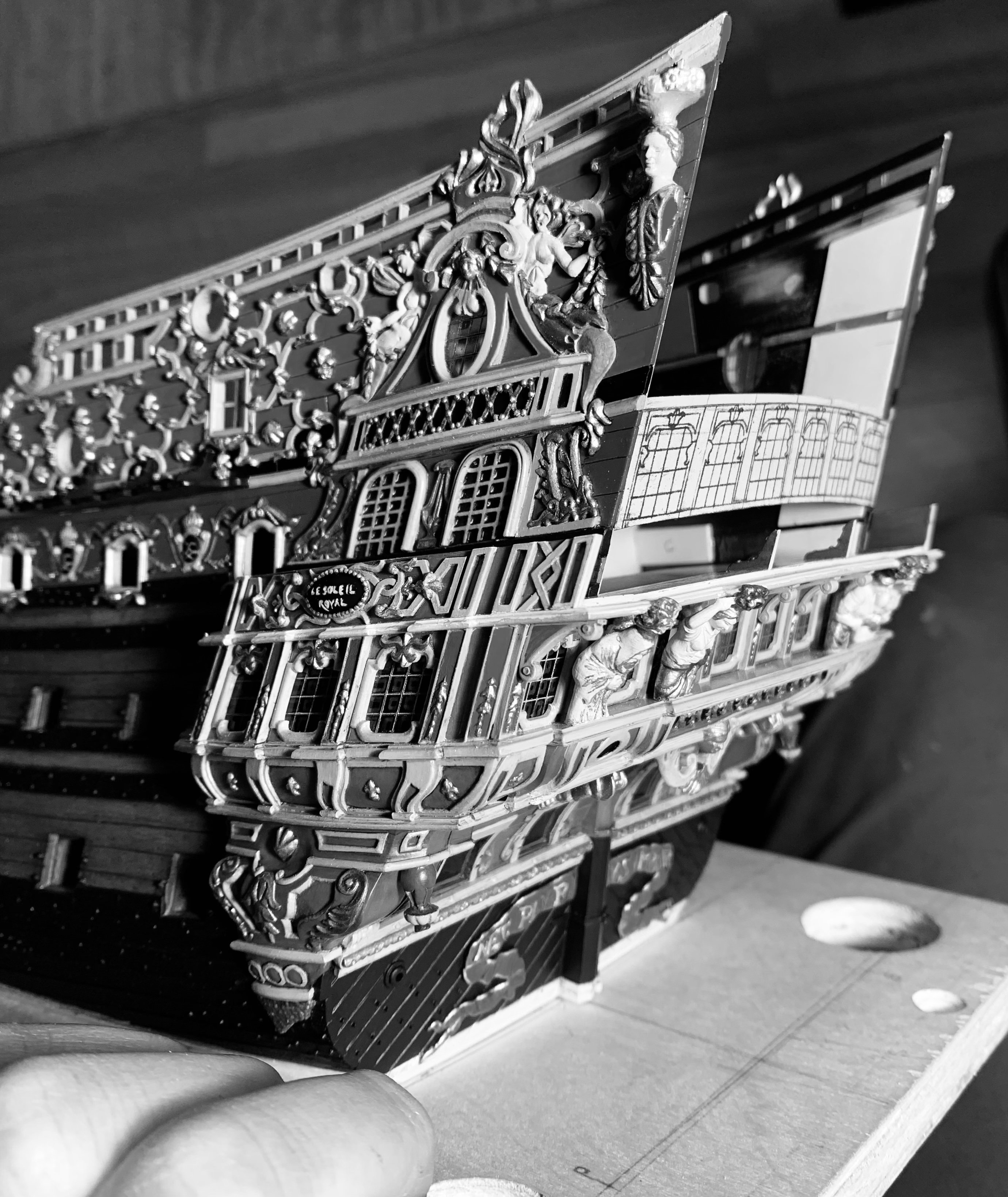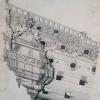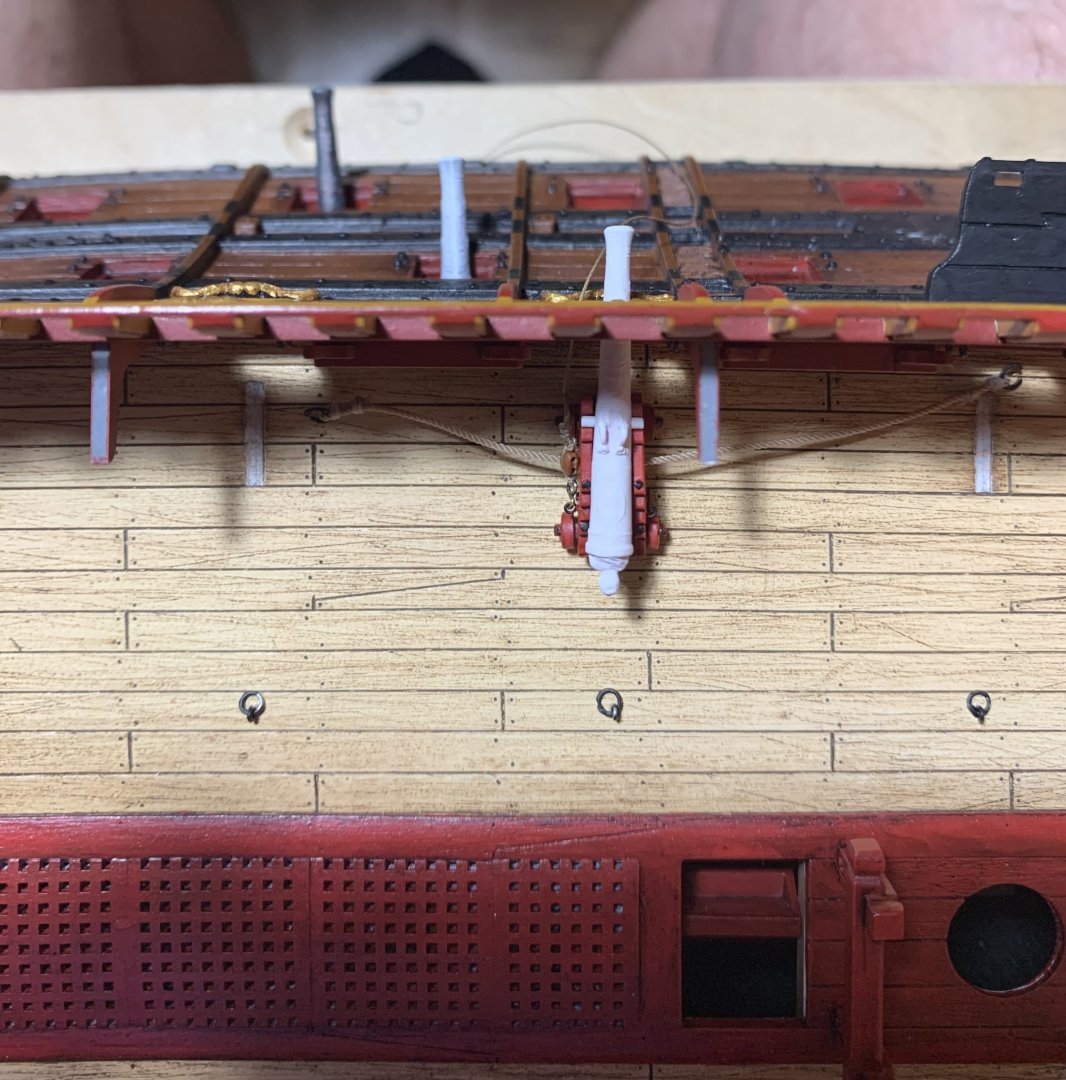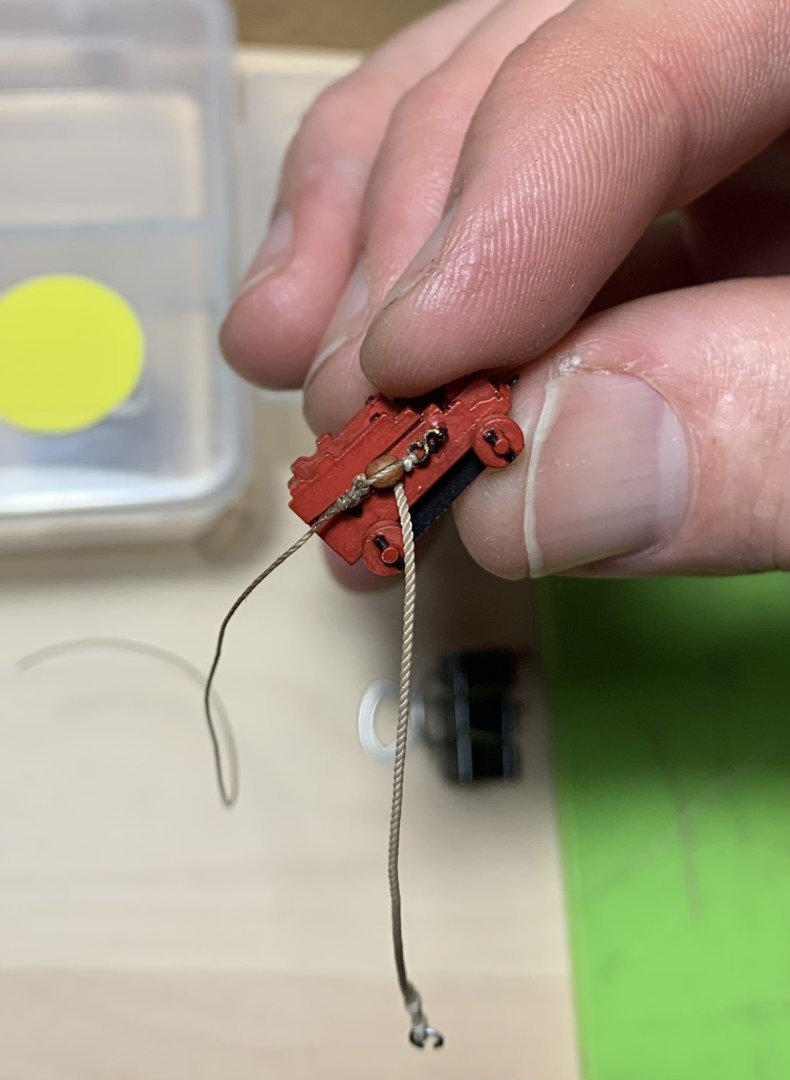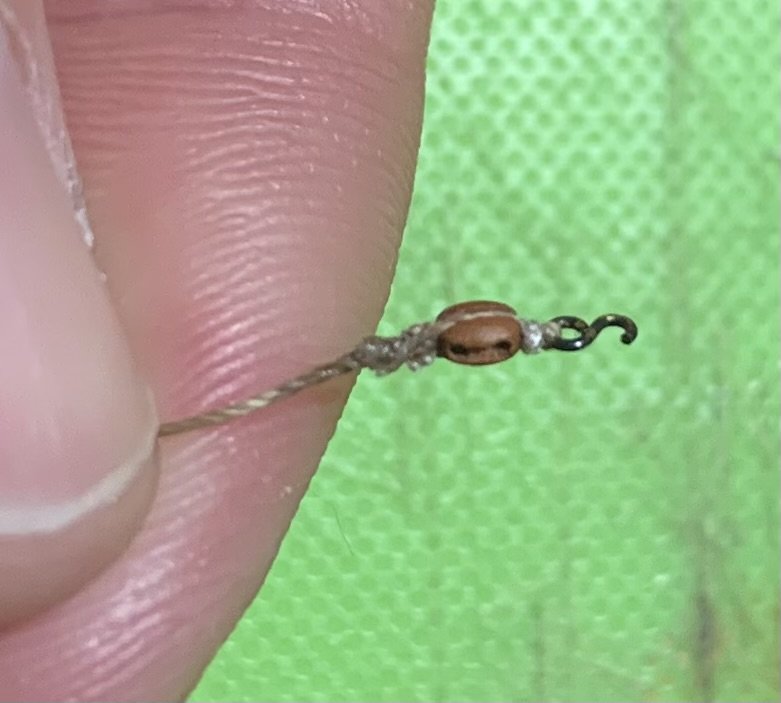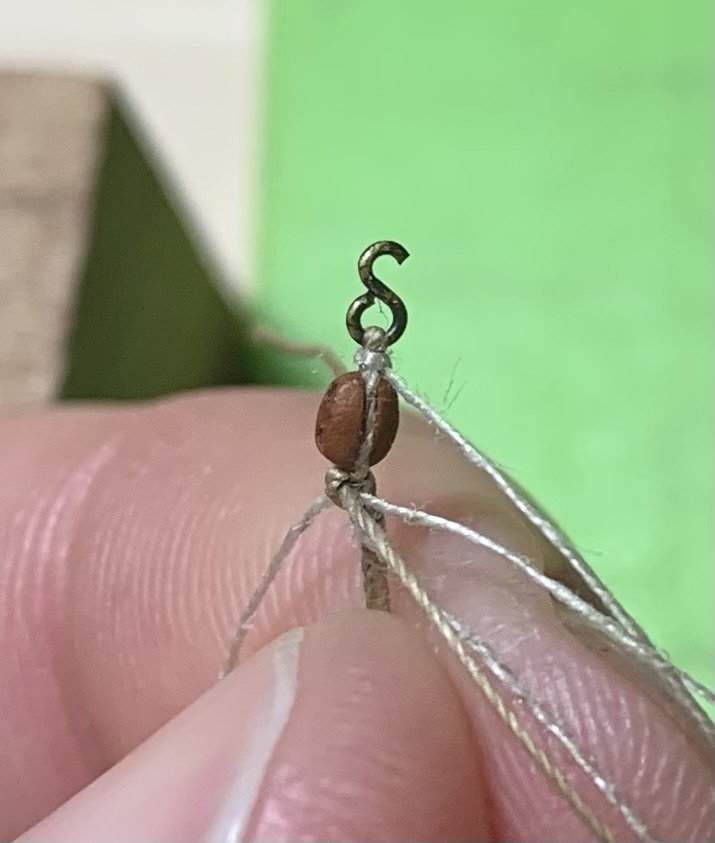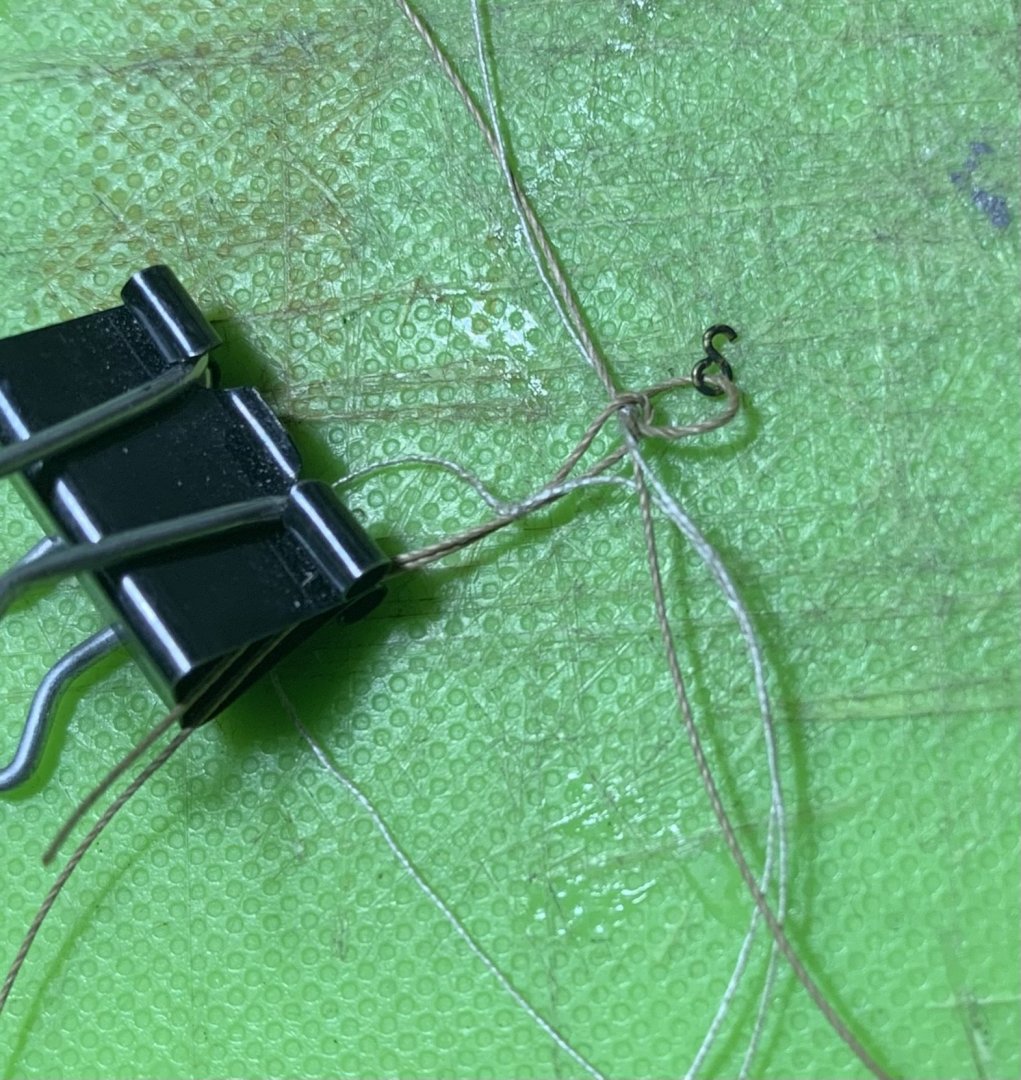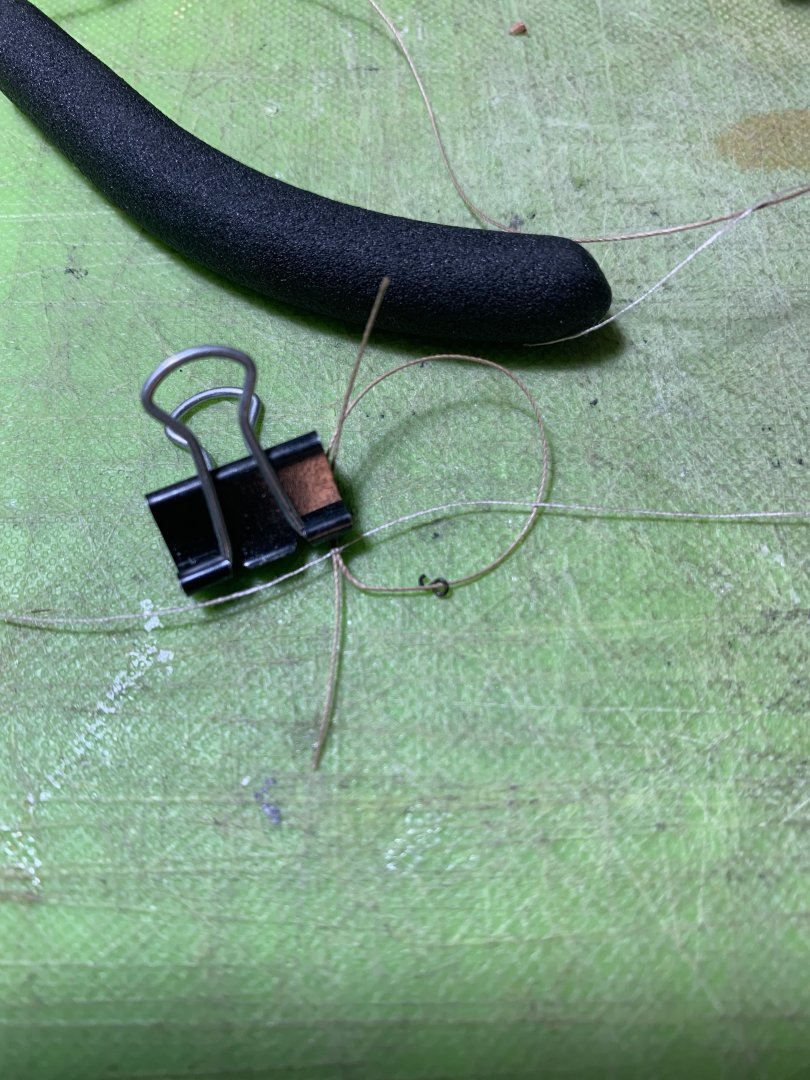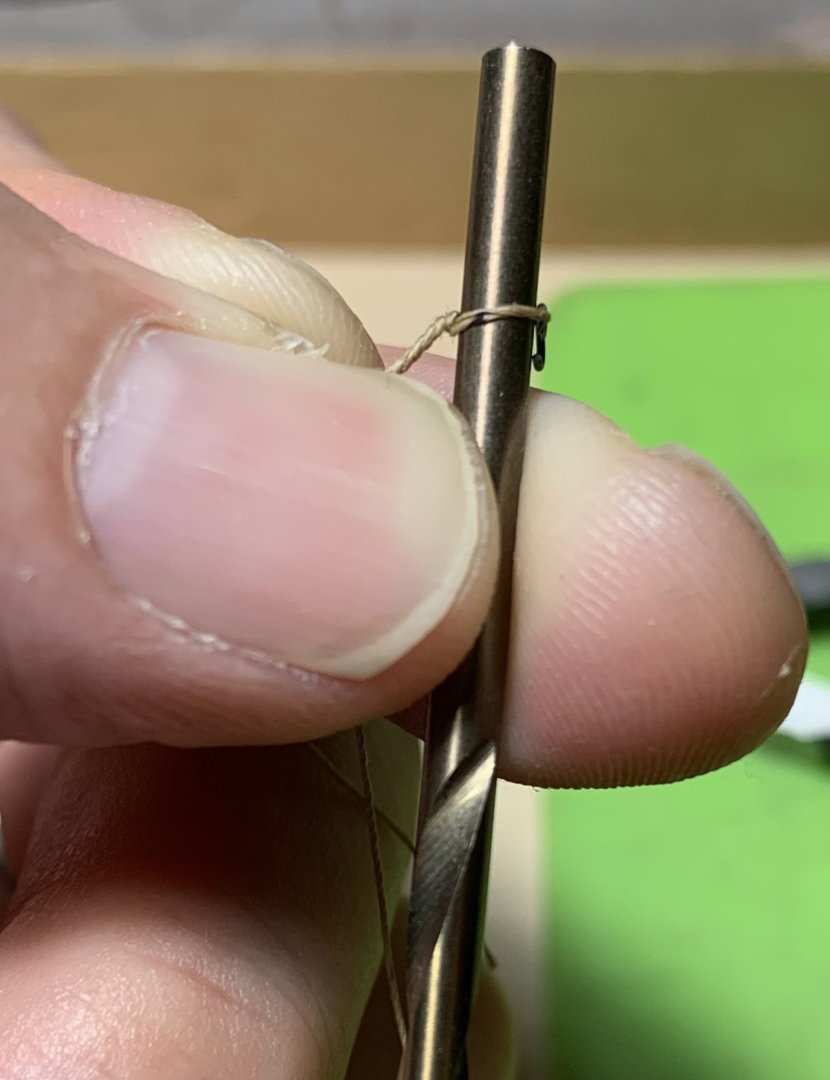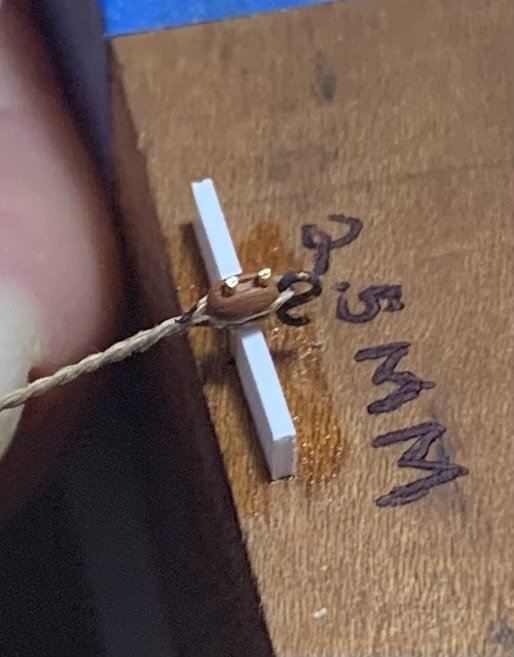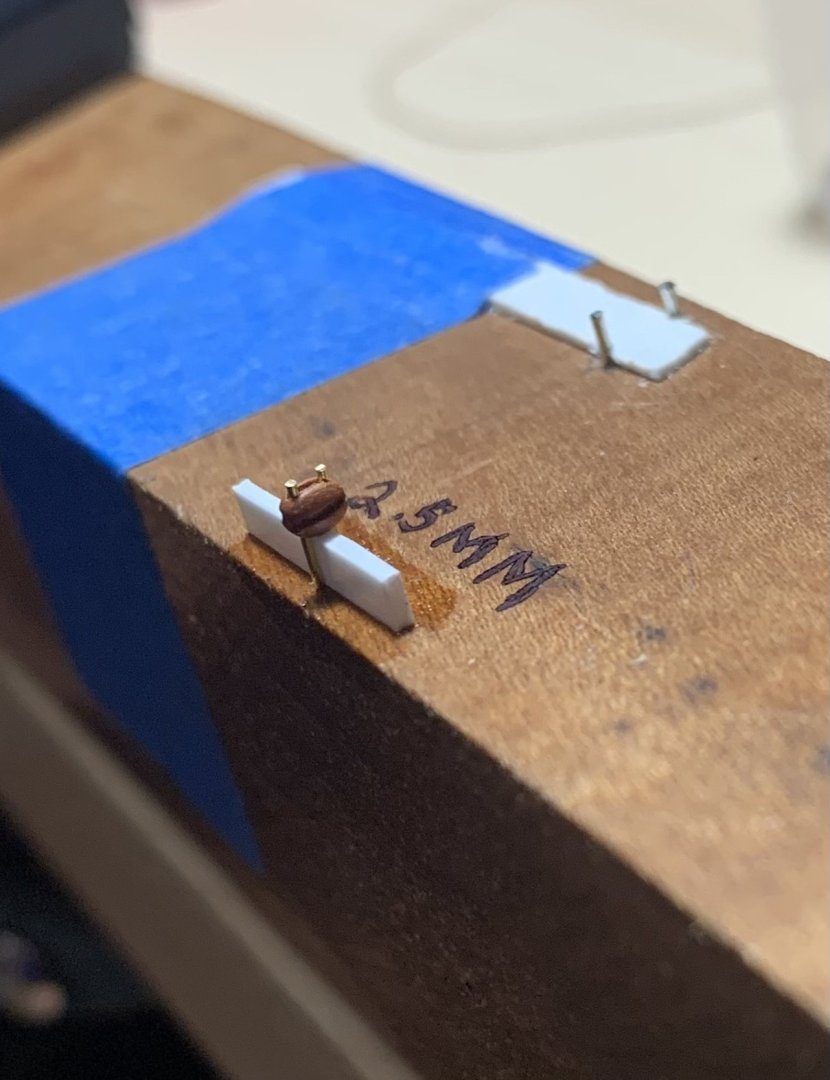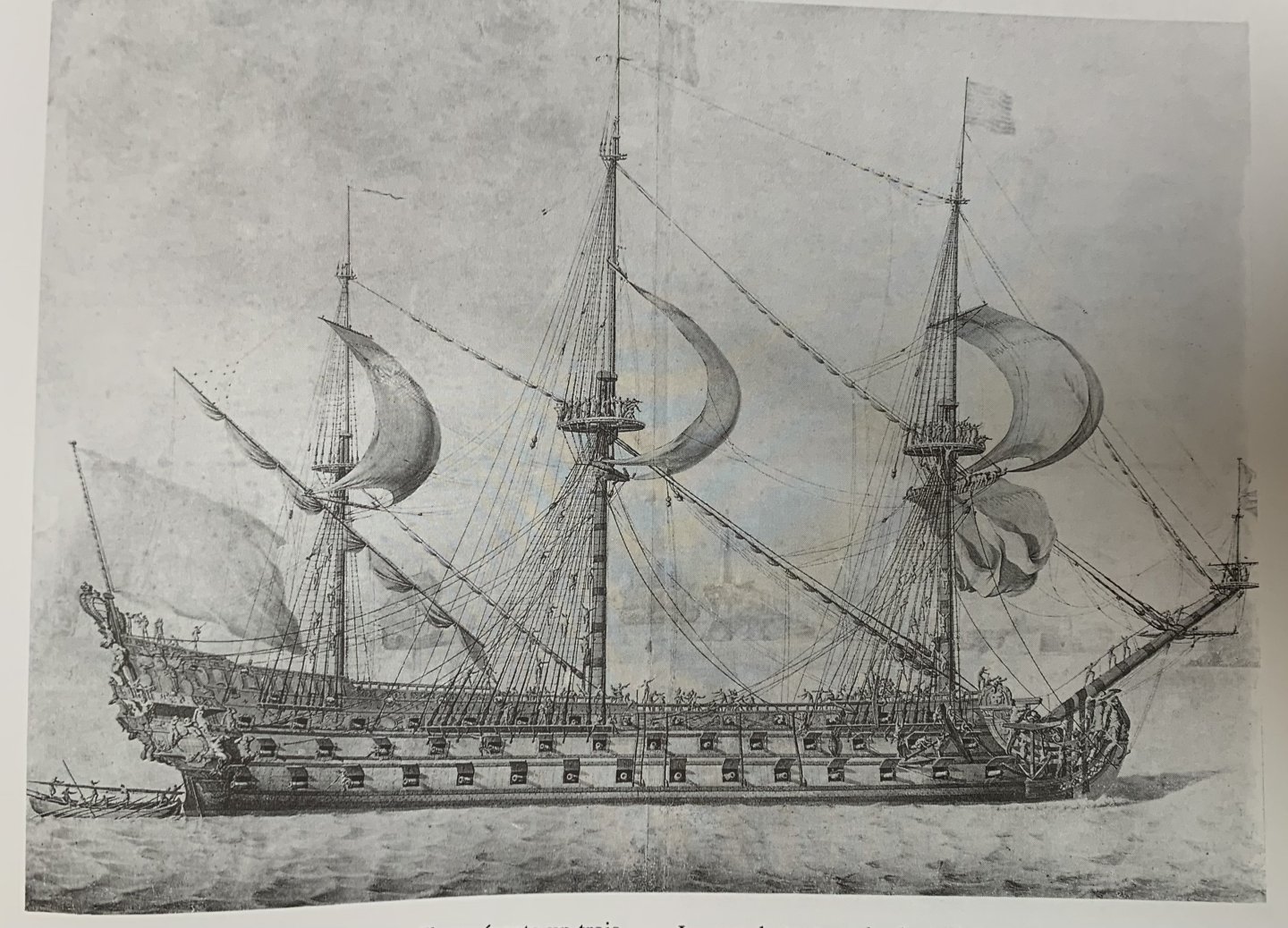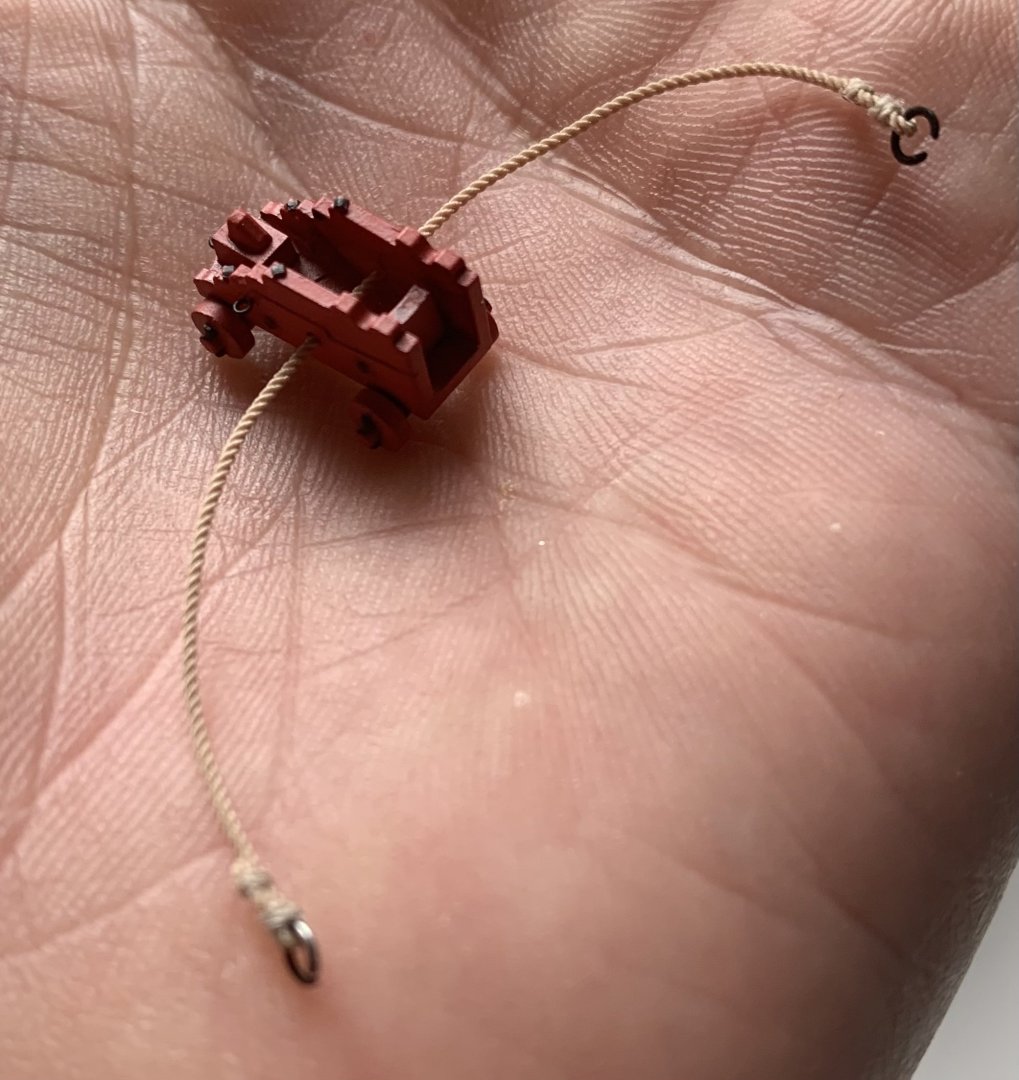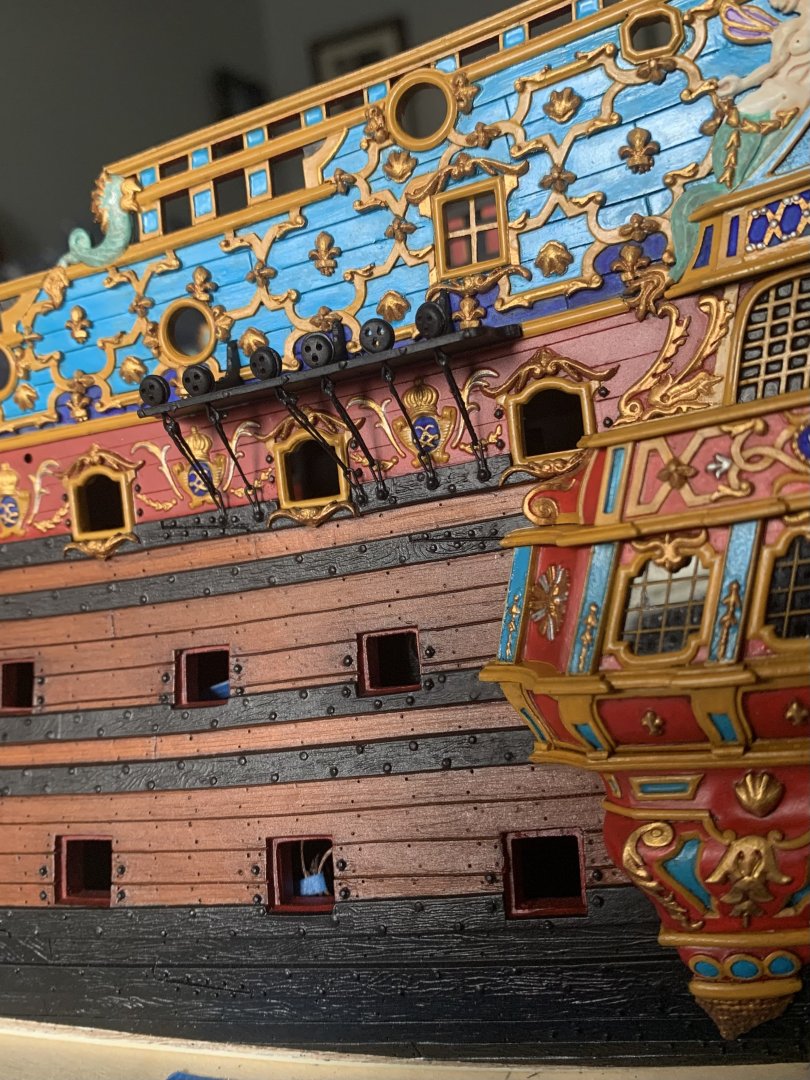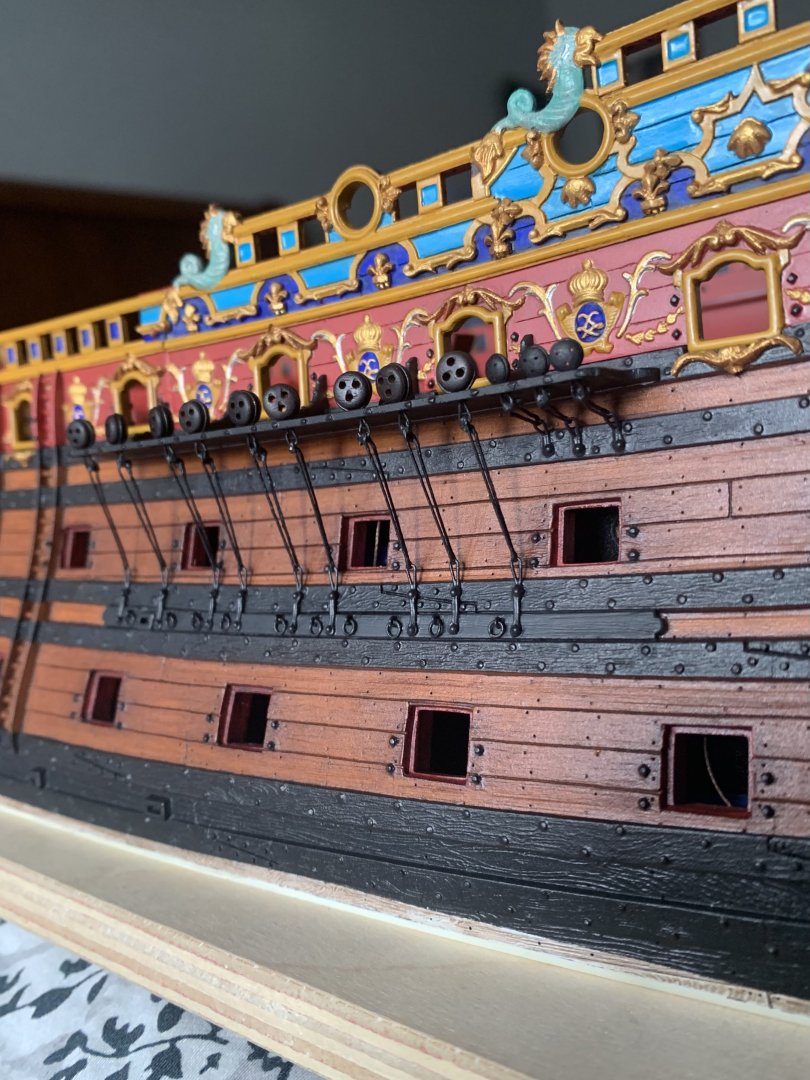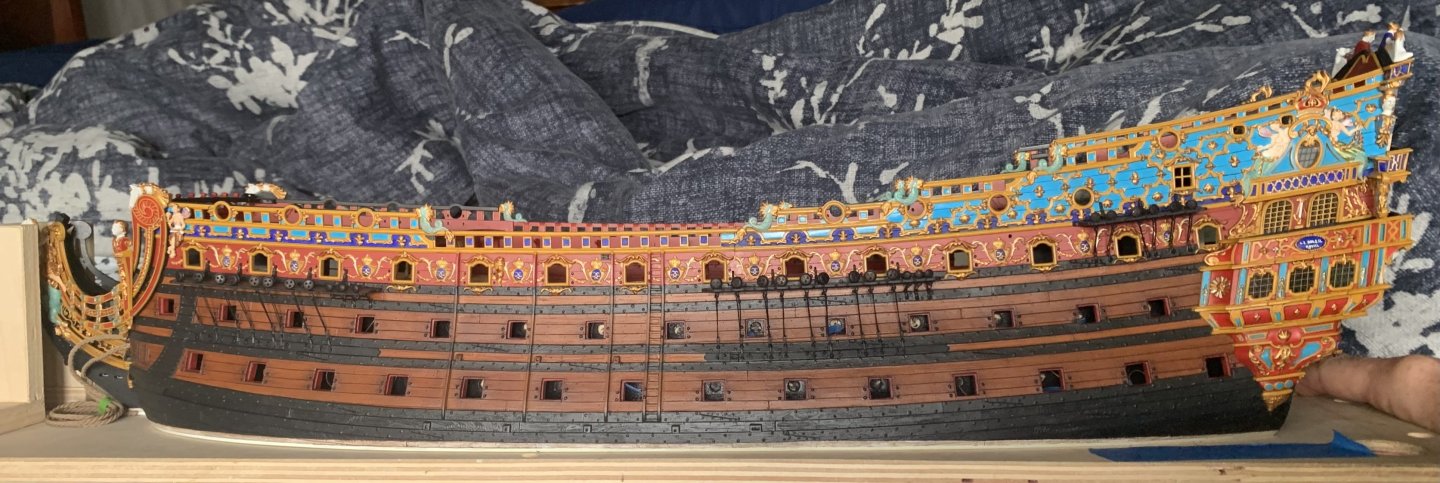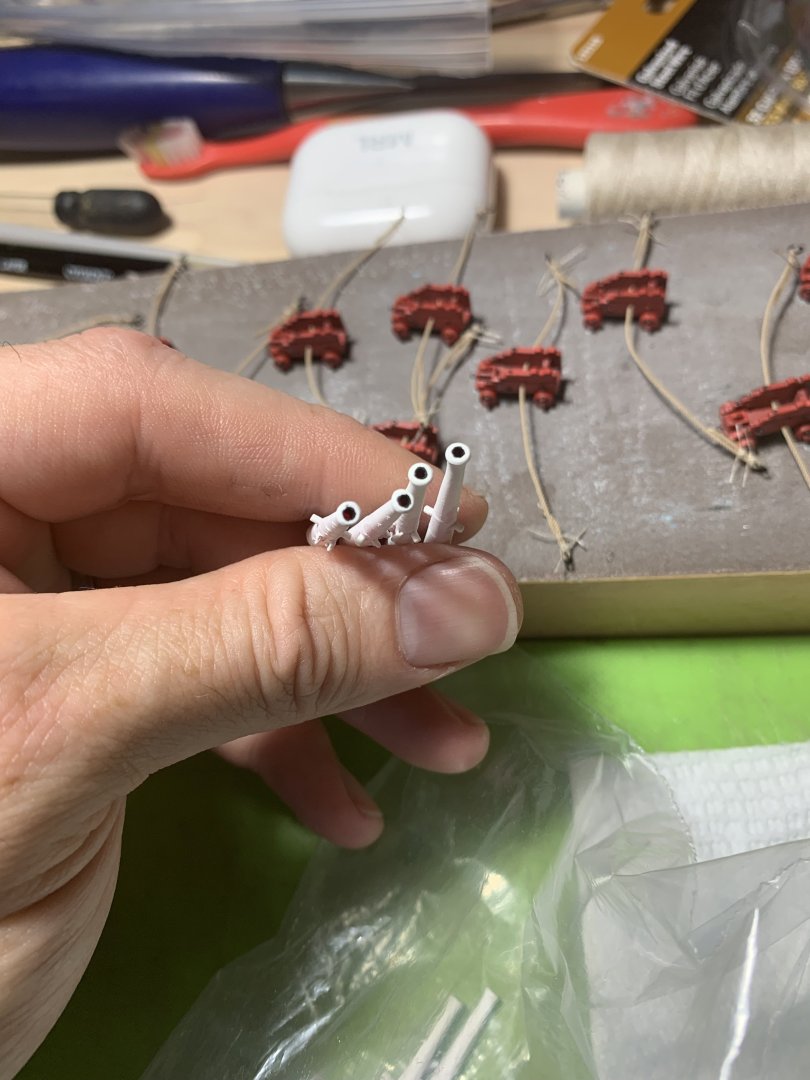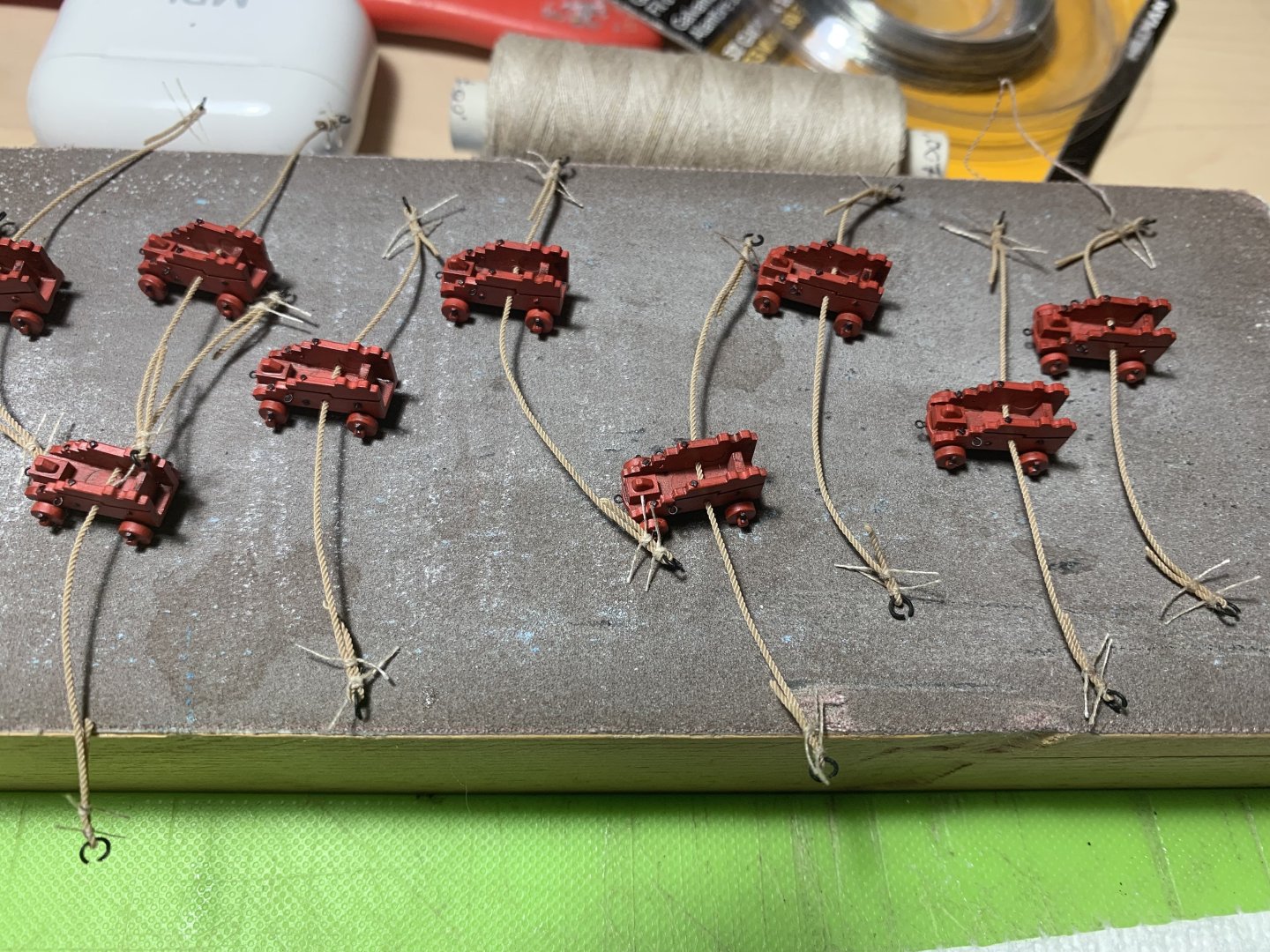-
Posts
3,280 -
Joined
-
Last visited
Content Type
Profiles
Forums
Gallery
Events
Everything posted by Hubac's Historian
-
Kevin - congrats on your pending retirement! I am a little envious of you guys. Bill, after working your whole life and raising a family, there is no such thing as “too much time in the shipyard.” Maurice is a really talented guy. What he did with that Heller 74 is astounding, and his wooden builds have also been top-notch! His sails, for me, were just pure magic. I spent the better part of yesterday’s free time digging through Dafi’s Victory log for better insight into how to convincingly rig carriage tackles in 1:96. As usual, Daniel did not disappoint! I modified some of his approach to suit my objective. I had made up a bunch of hooks that are as small as I can muster at just about 2.5 MM, matching the single and double blocks that I’m using for these 16 visible main deck guns. I used the brass wire again, but this time I both stripped the coating and abraded the surface with a grey Scotch-Brite pad. I was hoping to not have to paint these hooks, and this time the JAX blackened the lot fairly immediately: Nevertheless, the oxidation does not seem very resilient to handling. It looks like I’ll be swiping these with a little black paint before installation, anyway. I wonder whether the Birchwood Casey brass black is just a better product for this application. I see a lot of guys using it with great and instantaneous results. Later in the evening, I set to work designing a process to strap the single blocks with a hook, while also attaching the lanyard to the block strap with an eyelet. I was aiming to minimize any unnecessary bulk from overhand knots. For the sake of experimentation, I used some common polyester line that pretty closely matches the .35 mm laid line that I will use for the block straps. I only bought a little of this line from Ropes of Scale, for the time being, to get me started. I’ll have to see what it looks like, but I think I will use the common thread for the lanyards and their flaked coils, and the laid line on the straps where that difference is more apparent. I made a simple pin jig that will elevate and hold both the single and double blocks for strapping. I wanted to get a sense for the circumference around the single blocks, so that I would know what size drill bit to use as a mandrel for pre-setting the strap opening. I marked the test line with a pen: It turns out that an 1/8” drill bit leaves enough slack that I can do a short seizing close to the base of the hook: After thinking this process through a little further, it dawned on me that the way to approach this is to simply create that short seizing around the hook, first, with my .007 linen line. Then, make an oversize throat seizing of a single-overhand knot X2, on the backside of the strap. Before placing the strap back over the mandrel, make a loose eyelet for the lanyard, around the back end of the strap. With the strap over the mandrel, you can now pull the strap ends taught around the mandrel. After slipping your strap/lanyard assembly off the mandrel, you can now tack the hook end onto the “out” end of the block with a dot of CA. Once that sets, you can now cinch the strap tight into the groove of the block. Following that you can push the simple seize of the lanyard into a tight eyelet around the “in” end of the block. I use Kirrill’s technique of alternating, single overhand knots to walk out a 4-wrap simple seizing. All of this will be fixed with dilute white glue before snipping off the loose ends. A photo montage of my process: Now, my argument for not using expensive laid line for the lanyard is that there will be so little visible space between the single and double blocks. I did a few visual checks to see how far in-board I could place the carriages before the outboard portion of the gun barrels looked too short, relative to the middle and lower batteries: This is about the limit of what’s reasonable: The depth of these two lower batteries is pretty well fixed as these barrels plug into pre-established dummy blocks on the lower decks. This looks reasonable to me. As I embark on this process of gun rigging, it is immediately apparent to me why builders shy away from these huge 100-gunners, and I’m only rigging a small fraction if those guns! Thank you for looking in. More to follow.. Best, Marc
- 2,678 replies
-
- heller
- soleil royal
-
(and 9 more)
Tagged with:
-
Hi Kevin - Yes, I was following Bruma’s Cutty Sark, and I have commented on the excellence of his sails. They truly are great. My first inclination, though, is to try a technique with silk span that I first saw on a build by Blue Ensign - his Heller kitbash of La Superb. Silkspan seems to give the right scale impression for 1:96. If I’m being a little over-critical, I find that the material Bruma used felt a little heavy. His approach may ultimately be necessary, though, to achieve such a deep billowing effect. SR kit prices have been all over the place. If you have an early pressing, you are in luck, as the plastic remains excellent, so long as the kit has not been stored through temperature extremes. As you know, I have a deep respect for your computer modeling skills, and your hand-skills in bringing it all together. Your results are worth whatever wait is necessary. Although I have the Airfix Vasa and Prince in my stash, I am growing doubtful that I will ever get to building them, as I want to begin transitioning to wood on my next project. Why can’t this be my job?
- 2,678 replies
-
- heller
- soleil royal
-
(and 9 more)
Tagged with:
-
Well, Bill, I was thinking today about how much I enjoyed scratch-building the structural and ornamental aspects of the build. At this stage, though, the rigging looks like a steep, uphill climb. The trouble is that I’ve established a standard for the model, and I can’t just do what I’ve done on earlier builds for the rigging. I won’t be happy with that. In this scale, it is not really possible to construct ALL aspects of the rig to full scale practice, but I want it to look like that. Right now, I’m figuring out how best to strap single and double blocks with hooks for my carriage tackles. As you know, the available space to do so is impossibly small. I’m reading through Dafi’s Victory log because he has so many ingenious jigs and work-arounds for creating scale rigging effects. Because I’m so relatively un-skilled at this aspect of model-making, the going is very slow, and I really have to try not to get overwhelmed by the enormity of the task. I know, as with anything else, that I will acquire skill and confidence, and the process will pick up momentum. I find it somewhat helpful to think of each rigging element as a structure, in itself: what is its geometry? what are its component parts? what was it designed to do? On the other hand, if I spend too much time thinking about the finish line, I get an awfully strong desire to box the whole thing up and start a new project. I have too much time invested to not see it through, though. I keep the fire alive thinking about these fantastically billowing topsails that I will eventually try to re-create: This Puget portrait of the Royal Louis is the original inspiration for this diorama, and this version of the RL, circa 1692, is strongly analogous to what SR 1689 would have looked like. One foot in front of the other. Just keep on going, as I am telling my kids all of the time. As ever, I am grateful for the help and support of the community.
- 2,678 replies
-
- heller
- soleil royal
-
(and 9 more)
Tagged with:
-
That is an excellent tip, David - thank you!
- 2,678 replies
-
- heller
- soleil royal
-
(and 9 more)
Tagged with:
-
I’ve invested my hopes and dreams in my best pair of tweezers. I’ll keep you posted!
- 2,678 replies
-
- heller
- soleil royal
-
(and 9 more)
Tagged with:
-
That is very kind of you to say, Mark - much appreciated!
- 2,678 replies
-
- heller
- soleil royal
-
(and 9 more)
Tagged with:
-
Makes sense - the deadeye lashings enable you to tighten the shrouds, as needed.
- 294 replies
-
- Sovereign of the Seas
- Airfix
-
(and 1 more)
Tagged with:
-
That is really interesting how they are rigged with deadeyes on one side - well done!
- 294 replies
-
- Sovereign of the Seas
- Airfix
-
(and 1 more)
Tagged with:
-
I do have both of those books in my library, Bill, although Marquardt is on-loan from a friend. Excellent references, both.
- 2,678 replies
-
- heller
- soleil royal
-
(and 9 more)
Tagged with:
-
I think it was a good idea to pad up your sheer steps. I also think planking the inner bulwarks is a good idea, as your sanding away of detail appears to have made your bulwarks quite thin. The inner planking would provide an easy way to create the port lid rebates for those main and quarter deck square ports that are housed.
- 382 replies
-
- soleil royal
- Heller
-
(and 1 more)
Tagged with:
-
I have been absent for a good long time, but work does continue - albeit, at a snail’s pace. I have 99%, with the exception of the mizzen backstay stool that I have yet to make, completed the port side chains: With all the black touched up, and the thread links painted over with black acrylic, I am quite satisfied with the result: If you know to look for them, the knots on these long links can be found behind the deadeye strops, however, the theater convention of painting anything you don’t wish to draw attention to, flat-black, serves me well here. I could, perhaps, have extended the aft most backstay chain on the fore and main channels to the mid-way point of the adjacent gun port, but I am not going to change that now. The open port lid obscures these chains, anyway. A big thanks goes out to Eric Wiberg, who first sourced these plastic model-railroading round-headed bolts. They really worked perfectly in this application! Mizzen chains: I’ve begun the process of equipping the visible main deck carriages with their breaching ropes. I am using .6MM polyester line for these breaching ropes and .007 linen line for the seizings. I am aware that CA discolors polyester line, so I have secured the seizings with dilute Elmer’s white glue. I am taking a calculated risk that I can work around an earlier mistake without wasting all of the line and effort of making these seizings. Unfortunately, when I was detailing the inner bulwarks, I did not realize it was a mistake to glue-in the lower breaching rope eye-bolt. It is far easier to connect this eye bolt to your breaching rope split ring, off of the model, and then to glue the bolt to its bulwark location after the gun has been secured: So, the risk is that I can close these rings around the eye-bolts, often in tight spaces, without breaking anything or crushing the rings into an oval shape. This seemed to me a preferable approach to trying to break out the eye-bolts, which I recall being a snug fit: I will have to make a bunch of hooks and single/double block seizings for the haul-in tackles. I won’t, however, rig the haul-out tackles as I think they tend to make the decks look cluttered, and for the purposes of this diorama - SR making sail from Brest for Barfleur - I doubt these tackles would be rigged until just before engagement, as they present an encumbrance to sailors as they work the decks. I will soon paint the cannon barrels. Here, I’ve blacked-out the bores: I learned from the lower main deck guns not to paint the bronze and ver-de-gris wash until you are ready to mount in the carriages. The wash has an awful tendency to stick to itself. As always, thank you for your likes, comments and continued interest in this project. Little by little, we are getting there!
- 2,678 replies
-
- heller
- soleil royal
-
(and 9 more)
Tagged with:
-
So, the best explanation I can offer as to why only some of the main and quarter deck ports have lids is that, during this early time period, the French used ports on guns that were fully housed by a deck above. So, the main deck guns beneath the f’ocsle and quarter decks would have lids. The guns in the waist were fully open to the elements, and watershed would happen through the scuppers. Likewise, the aft two QD guns are housed beneath the poop deck. What you are seeing along the top sheer rails is not a solid wooden frieze carving, but instead a series of “fighting cloths.” The poop, QD and f’ocsle rails, in preparation for battle, were blanketed in these cloths which helped give at least some cover to the seamen on deck, from the fusillade fire of opposing marines. On this Monamy painting of SR, you can see these cloths in royal blue. They are adorned with painted-on Fleur de Lis: Beneath these cloths are the conventional timber head railings you typically see. I have considered modeling these cloths on one side of my model, but I’m not sure I could do so convincingly well. Those four openings above the lowest tier of the quarter gallery would be the windows one typically finds in the upper tiers of the quarter gallery. In the absence of an elaborately architectural amortisement, it appears that La Reyne simply had these windows, framed in ornamental ginger-bread, set amidst a frieze of fleurs that decorated all of the upper bulwarks, above the main deck guns.
- 382 replies
-
- soleil royal
- Heller
-
(and 1 more)
Tagged with:
-
The minute scale of it all makes it super impressive.
- 294 replies
-
- Sovereign of the Seas
- Airfix
-
(and 1 more)
Tagged with:
About us
Modelshipworld - Advancing Ship Modeling through Research
SSL Secured
Your security is important for us so this Website is SSL-Secured
NRG Mailing Address
Nautical Research Guild
237 South Lincoln Street
Westmont IL, 60559-1917
Model Ship World ® and the MSW logo are Registered Trademarks, and belong to the Nautical Research Guild (United States Patent and Trademark Office: No. 6,929,264 & No. 6,929,274, registered Dec. 20, 2022)
Helpful Links
About the NRG
If you enjoy building ship models that are historically accurate as well as beautiful, then The Nautical Research Guild (NRG) is just right for you.
The Guild is a non-profit educational organization whose mission is to “Advance Ship Modeling Through Research”. We provide support to our members in their efforts to raise the quality of their model ships.
The Nautical Research Guild has published our world-renowned quarterly magazine, The Nautical Research Journal, since 1955. The pages of the Journal are full of articles by accomplished ship modelers who show you how they create those exquisite details on their models, and by maritime historians who show you the correct details to build. The Journal is available in both print and digital editions. Go to the NRG web site (www.thenrg.org) to download a complimentary digital copy of the Journal. The NRG also publishes plan sets, books and compilations of back issues of the Journal and the former Ships in Scale and Model Ship Builder magazines.

